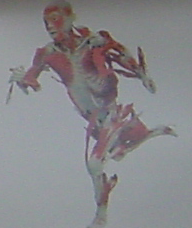|
|
"Bodies: The Exhibition" is a controversial exhibit consisting of 20 human cadavers and 260 body parts that have undergone a process called plastination, which involves removing the fats and "precious bodily fluids" as Dr. Strangelove would say, and replacing them with liquid silicone rubber. The process preserves the bodies and allows them to be posed. The exhibition has been held in Europe and is currently at the The Exhibition Centre at the South Street Seaport in Manhattan until February 28, 2006 and the Museum of Science and Industry (MOSI) in Tampa Florida until April 2, 2006, which is where I saw it during its opening week in August.
The museum says the purpose of the exhibit is to interest students in science and anatomy and encourage healthy lifestyle choices, but it was hard for me to believe this is what drew over 20,000 visitors the first week (thousands more are expected to attend in the months ahead). I figured it more likely that their interest was piqued by the controversy involving the exhibit. Three days before the exhibition opened, Florida's Anatomical Board, which monitors the transport of cadavers and body parts in and out of the state, voted against allowing it to open. People must give their consent for their bodies to be used for educational or medical purposes. The bodies in the exhibit are those of unclaimed or unidentified individuals from the People’s Republic of China, who were obtained without permission from the individuals themselves or their families.
 |
I decided to quell my queasiness and see for myself what the excitement was about. Due to the large numbers of people attending, we had to queue up and slowly make our way to a series of rooms. Throughout were bodies posed in vaious positions: kicking a soccer ball, playing chess, gesturing. Enclosed in glass cases were numerous body parts, some of which had been diseased with tumors, emphysema or cancer. An area off to the side, with a posted warning that this part of the exhibit might be disturbing to some viewers, housed fetuses in various stages of development.
It’s not the body parts, the muscle, sinew, spinal cords, or even the fetuses that I found disconcerting. It’s the eyelashes, the hand with skin and fingernails, the curve of an ear. It’s the eyes that look at you as if to say, "Who are you and what on earth am I doing here, being stared at by a bunch of white people, posed in some ridiculous position? Hell, I don’t even like soccer, never mind play the damn thing!" You wonder who these people were, what kinds of lives they lived, what quality of medical care, if any, they received that left them to die from huge metastasizing breast tumors or lungs blackened by disease. After all, China’s record on human rights isn’t exactly exemplary.
And does it really matter whether or not these people gave permission? They’re dead and no longer concerned with such matters, after all. When you think about it, being preserved and displayed in an exhibit doesn’t compare unfavorably to being buried in the ground or cremated. In a sense, it makes one, or at least one’s remains, immortal, unless intentionally or unintentionally later destroyed, of course.
I expected the other attendees to be sensation-seekers, uttering comments along the lines of cool, gross, yuck, wow, look at the dead guy, that kind of thing. I am pleased to say that every visitor I saw acted with great reverence. There was no laughter, no joking, just quiet comments and serious faces. Maybe they were fascinated with the body. Maybe they were thinking about their own mortality, and wondering whether this was all there was to these people or just the package that housed a soul, an essence, something that still existed somewhere.
It occurred to me that perhaps the reason people were here was not to learn about anatomy or ponder the mysteries of life or be grossed out but a morbid curiosity to experience seeing a dead, flayed, unadorned human being up close. We are engulfed in virtual death coming at us from movies, TV shows and video games but rarely do we have to face the real thing.
—Lin Black
Copyright©EighthSquare.com P.O. Box 580, New York, NY 10113

